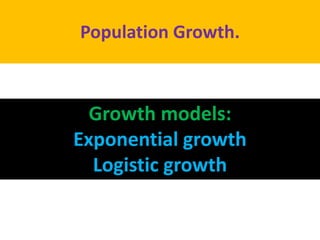
Population growth
- 1. Population Growth. Growth models: Exponential growth Logistic growth
- 2. The size of a population for any species is not a static parameter • Population keeps changing with time. • Population changes depending on various factors. • food availability, • predation • Atmospheric pressure • adverse weather.
- 3. The population changes in a given habitat due to changes in four basic processes: • Natality • Mortality • Immigration • Emigration • Natality and Immigration: increase population density.. • Mortality and emigration decrease population density..
- 4. • Natality refers to the number of births in the population during a given period. • Mortality is the number of deaths in the population during a given period.
- 5. • Immigration is the number of individuals of the same species that have come into the habitat from elsewhere during the time period. • Emigration is the number of individuals of the population who left the habitat and gone elsewhere during the time period under.
- 7. • Nt+1 = Nt + [(B + I) – (D + E)] • N is the population density at time t, • then its density at time t +1 is
- 8. • Population density will increase if the number of births + immigrants (B + I) is more than the number of deaths + emigrants (D + E). • For instance, if a new habitat is just being colonised, immigration may contribute more significantly to population growth than birth rates
- 9. Growth Models : • Exponential growth: • Logistic growth:
- 11. Exponential growth: • Resource (food and space) availability is essential for the growth of a population. • When resources in the habitat are unlimited, each species has potential to grow in number: • Observed by Darwin while developing his theory of natural selection.
- 12. • When food and space are available the population of species grows in an exponential or geometric fashion. • Darwin showed how even a slow growing animal like elephant could reach enormous numbers in the absence of checks.
- 13. • If in a population of size N. • b = the birth rates • d = death rates • Increase or decrease in N during a unit time period t • dN/dt = (b – d) × N • (b–d) = r dN/dt = rN
- 14. • The “r” in this equation is called the ‘intrinsic rate of natural increase’ • “r” values, for the Norway rat is 0.015. • The flour beetle it is 0.12. • In 1981, the “r” value for human population in India was 0.0205..
- 15. when we plot N in relation to time results in a J-shaped curve..
- 16. • The integral form of the exponential growth equation as • Nt = N0 ert • Nt = Population density after time t • N0 = Population density at time zero • r = intrinsic rate of natural increase • e = the base of natural logarithms (2.71828)
- 17. • Paramecium starting with just one individual and through binary fission, doubling in numbers every day, • Then imagine after 64 days the population size (food and space remain unlimited)
- 18. Logistic growth or Verhulst-Pearl Logistic Growth
- 19. • A population growing in a habitat with limited resources show initially : • lag phase, • acceleration • deceleration • and finally an asymptote (Zero).
- 20. A plot of N in relation to time (t) results in a sigmoid curve.
- 21. • =dN/dt= rN (K-N/K) • N = Population density at time t • r = Intrinsic rate of natural increase • K = Carrying capacity • K= In a given habitat has enough resources to support a maximum possible number, beyond which no further growth is possible..
- 22. No population of any species in nature has its disposal unlimited resources to permit exponential growth". • This leads to competition between individuals for limited resources. • Only the ‘fittest’ individual will survive and reproduce.
- 23. • The governments of many countries have also realised this fact.. • and introduced various restraints (controls) with a view to limit human population growth..
- 24. Harinatha Reddy Aswartha Assistant Professor Department of Microbiology biohari14@gmail.com
